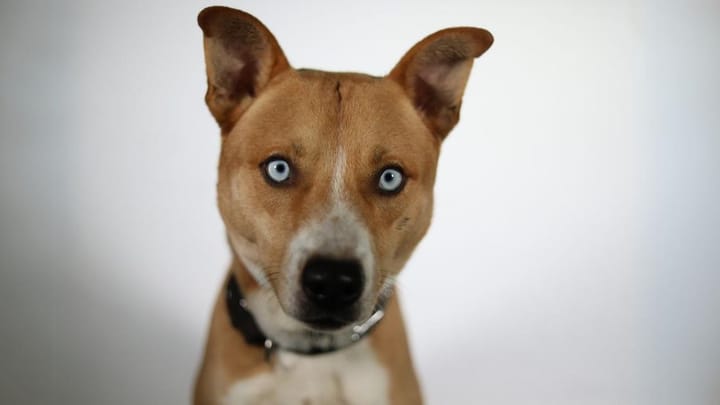Pitsky

The Pitsky is a hybrid dog breed resulting from the cross between a Pitbull Terrier and a Siberian Husky. This unique combination blends the boundless energy and resilience of the Pitbull with the intelligence and endurance of the Husky. The Pitsky is renowned for its striking appearance, typically featuring a dense coat, piercing eyes, and an athletic build.
While often affectionate and loyal, this energetic dog requires firm, consistent training and regular exercise to help channel its energy and prevent undesirable behaviours. The Pitsky can be an excellent companion for active families or individuals prepared to meet the challenge of raising a dog with a strong temperament and assertive personality.
|
Life expectancy |
The Pitsky has a life expectancy of between 12 and 15 years |
|
Temperament |
|
|
Size |
Medium
|
|
Adult size |
Female
Between 18 and 24 in
Male
Between 18 and 24 in
|
|
Adult weight |
Female
Between 40 and 66 lb
Male
Between 40 and 66 lb
|
|
Coat colour
|
Black White Brown Blue Red |
|
Type of coat
|
Short Long |
|
Eye colour
|
Blue
Brown
Odd-eyed
|
|
Purchase price |
The Pitsky costs between £400 and £1500 |
The Pitsky is an energetic and intelligent crossbreed, combining the loyalty of the Pitbull and the endurance of the Husky. While affectionate and playful, it requires consistent training, regular exercise, and mental stimulation. Due to its high energy, it’s best suited to active families or individuals with experience in handling strong, spirited dogs.
More details about the Pitsky
Pitsky: Origins and history
The Pitsky is a relatively recent crossbreed, deliberately created in the United States in the early 21st century. This hybrid combines the American Pitbull Terrier (a banned breed in the UK) and the Siberian Husky, two breeds known for their distinct characteristics: the Pitbull's strength and loyalty, and the Husky's intelligence and endurance. Although it has gained popularity in recent years, particularly due to its striking appearance and energetic personality, the Pitsky remains an unofficially recognised breed in kennel clubs. Despite its recent origins, it has attracted attention for its unique mix of traits, making it a fascinating choice for dog lovers in the UK looking for an active, intelligent, and affectionate companion. However, potential owners should be mindful that, as a hybrid, the Pitsky's behaviour and health can vary widely, depending on the traits inherited from each parent breed.
Pitsky: Characteristics
Pitsky: Behaviour
Training a Pitsky
Training a Pitsky requires consistency, patience, and positive reinforcement. Start with early socialisation and obedience training, using rewards to encourage good behaviour. Due to their intelligence and stubborn streak, short, engaging sessions work best. Regular mental and physical stimulation is key to preventing boredom and unwanted behaviours. A firm yet gentle approach ensures success.
Pitsky: Lifestyle
Breed compatibility Pitsky
Pitsky: Purchase price
As a designer breed, Pitsky puppies are relatively rare in the UK, and their prices can vary based on factors such as breeder reputation, lineage, and demand. You can expect to pay anything from £400 up to £1,500.
Owning a medium to large breed like the Pitsky also involves various monthly expenses, including the cost of high-quality food suitable for the dog's size and energy levels, routine veterinary care for check-ups, vaccinations, and potential health issues, regular grooming sessions to maintain the coat, accessories such as toys, leads, and bedding, and pet insurance to cover any unexpected medical costs.
Pitsky: Shedding
Average
Pitskies that inherit the Husky's thick double coat tend to shed more heavily, particularly during seasonal shedding periods. This requires regular brushing to manage the shedding and prevent tangles or matting. On the other hand, Pitskies with shorter coats, similar to the Pitbull's, experience more moderate shedding, and occasional brushing is typically sufficient to maintain the health of their skin and coat.
Pitsky: Grooming
Regardless of their coat type, regular grooming is essential to ensure a healthy, shiny coat and to keep shedding under control. Depending on their coat, Pitskies may also benefit from occasional baths to keep them clean and fresh.
Pitsky: Health
The Pitsky is generally regarded as a hardy and resilient dog. Inheriting the vitality of the Pitbull and the endurance of the Husky, this mixed breed typically enjoys good overall health. Thanks to the genetic diversity of both parent breeds, Pitskies are less likely to suffer from breed-specific genetic disorders.
The Pitsky can tolerate warm temperatures but is not particularly suited to extremely hot climates. Huskies, one of its parent breeds, originate from colder regions and may struggle to cool down in high heat. It is important to provide plenty of shade and fresh water on hot days to prevent heatstroke.
Due to their Siberian Husky heritage, Pitskies are well-suited to colder climates. Their dense coats, especially if they inherit the Husky’s double-layered fur, help keep them comfortable in cold weather. They are well-suited for outdoor activities during the winter and can tolerate low temperatures better than many other breeds.
Pitskies may have a moderate tendency to gain weight, particularly if they do not get enough exercise. A balanced diet and regular exercise routine are essential to maintaining their ideal weight. Monitoring their food intake and avoiding overfeeding will help prevent obesity and related health issues.
Pitskies can be prone to certain health issues, including hip dysplasia, hypothyroidism, eye problems, knee issues, and follicular dysplasia. Regular vet check-ups and a healthy lifestyle can help manage these risks.



